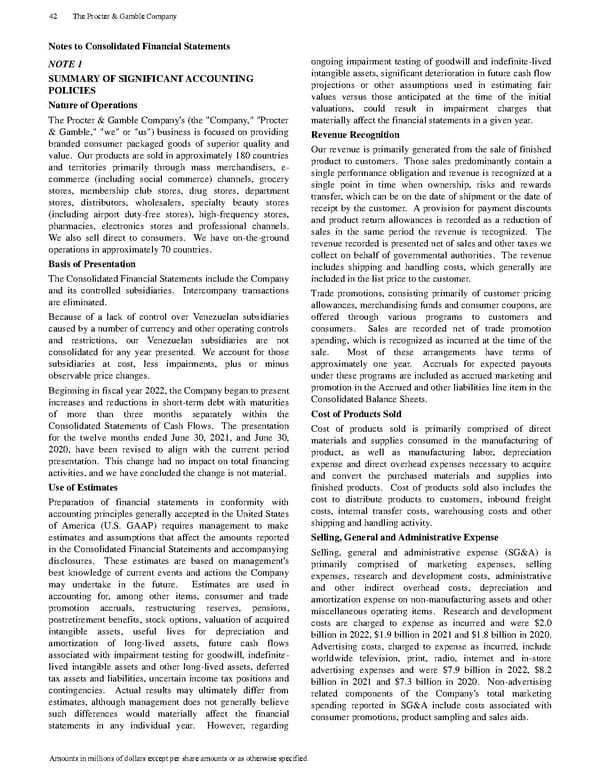Notes to Consolidated Financial Statements NOTE 1 SUMMARY OF SIGNIFICANT ACCOUNTING POLICIES Nature of Operations The Procter & Gamble Company's (the "Company," "Procter & Gamble," "we" or "us") business is focused on providing branded consumer packaged goods of superior quality and value. Our products are sold in approximately 180 countries and territories primarily through mass merchandisers, e - commerce (including social commerce) channels, grocery stores, membership club stores, drug stores, department stores, distributors, wholesalers, specialty beauty stores (including airport duty - free stores), high - frequency stores, pharmacies, electronics stores and professional channels. We also sell direct to consumers. We have on - the - ground operations in approximately 70 countries. Basis of Presentation The Consolidated Financial Statements include the Company and its controlled subsidiaries. Intercompany transactions are eliminated. Because of a lack of control over Venezuelan subsidiaries caused by a number of currency and other operating controls and restrictions, our Venezuelan subsidiaries are not consolidated for any year presented. We account for those subsidiaries at cost, less impairments, plus or minus observable price changes. Be ginning in fiscal year 2022, the Company began to present increases and reductions in short - term debt with maturities of more than three months separately within the Consolidated Statements of Cash Flows. The presentation for the twelve months ended June 30, 2021, and June 30, 2020, have been revised to align with the current period presentation. This change had no impact on total financing activities, and we have concluded the change is not material. Use of Estimates Preparation of financial statements i n conformity with accounting principles generally accepted in the United States of America (U.S. GAAP) requires management to make estimates and assumptions that affect the amounts reported in the Consolidated Financial Statements and accompanying disclosu res. These estimates are based on management's best knowledge of current events and actions the Company may undertake in the future. Estimates are used in accounting for, among other items, consumer and trade promotion accruals, restructuring reserves, p ensions, postretirement benefits, stock options, valuation of acquired intangible assets, useful lives for depreciation and amortization of long - lived assets, future cash flows associated with impairment testing for goodwill, indefinite - lived intangible as sets and other long - lived assets, deferred tax assets and liabilities, uncertain income tax positions and contingencies. Actual results may ultimately differ from estimates, although management does not generally believe such differences would materially affect the financial statements in any individual year. However, regarding ongoing impairment testing of goodwill and indefinite - lived intangible assets, significant deterioration in future cash flow projections or other assumptions used in estimating fai r values versus those anticipated at the time of the initial valuations, could result in impairment charges that materially affect the financial statements in a given year. Revenue Recognition Our revenue is primarily generated from the sale of finished pr oduct to customers. Those sales predominantly contain a single performance obligation and revenue is recognized at a single point in time when ownership, risks and rewards transfer, which can be on the date of shipment or the date of receipt by the custom er. A provision for payment discounts and product return allowances is recorded as a reduction of sales in the same period the revenue is recognized. The revenue recorded is presented net of sales and other taxes we collect on behalf of governmental auth orities. The revenue includes shipping and handling costs, which generally are included in the list price to the customer. Trade promotions, consisting primarily of customer pricing allowances, merchandising funds and consumer coupons, are offered throug h various programs to customers and consumers. Sales are recorded net of trade promotion spending, which is recognized as incurred at the time of the sale. Most of these arrangements have terms of approximately one year. Accruals for expected payouts un der these programs are included as accrued marketing and promotion in the Accrued and other liabilities line item in the Consolidated Balance Sheets. Cost of Products Sold Cost of products sold is primarily comprised of direct materials and supplies consumed in the manufacturing of product, as well as manufacturing labor, depreciation expense and direct overhead expenses necessary to acquire and convert the purchased materials and supplies into finished products. Cost of products sold also i ncludes the cost to distribute products to customers, inbound freight costs, internal transfer costs, warehousing costs and other shipping and handling activity. Selling, General and Administrative Expense Selling, general and administrative expense (SG&A) is primarily comprised of marketing expenses, selling expenses, research and development costs, administrative and other indirect overhead costs, depreciation and amortization expense on non - manufacturing assets and other miscellaneous operating items. R esearch and development costs are charged to expense as incurred and were $2.0 billion in 2022, $1.9 billion in 2021 and $1.8 billion in 2020. Advertising costs, charged to expense as incurred, include worldwide television, print, radio, internet and in - s tore advertising expenses and were $7.9 billion in 2022, $8.2 billion in 2021 and $7.3 billion in 2020. Non - advertising related components of the Company's total marketing spending reported in SG&A include costs associated with consumer promotions, produc t sampling and sales aids. 42 The Procter & Gamble Company Amounts in millions of dollars except per share amounts or as otherwise specified.
 The Procter & Gamble Annual Report Page 53 Page 55
The Procter & Gamble Annual Report Page 53 Page 55